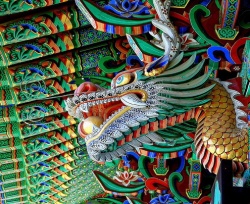Difference between revisions of "The Korean Dragon Tradition"
m (1 revision: Adminos 18 sept 02.04AM) |
|||
| Line 1: | Line 1: | ||
[[File:6a00d835.jpg|thumb|250px|]] | [[File:6a00d835.jpg|thumb|250px|]] | ||
| − | [[Korean]] [[dragons]] are probably less well known in the Western [[world]] than their {{Wiki|Chinese}} and [[Japanese]] counterparts however they are just as important. | + | [[Korean]] [[dragons]] are probably less well known in the {{Wiki|Western}} [[world]] than their {{Wiki|Chinese}} and [[Japanese]] counterparts however they are just as important. |
[[Korean]] [[dragons]] are generically known as Yong. There are three main sub-types: | [[Korean]] [[dragons]] are generically known as Yong. There are three main sub-types: | ||
| Line 8: | Line 8: | ||
* Yo | * Yo | ||
: The hornless ocean [[dragon]] | : The hornless ocean [[dragon]] | ||
| − | * Kyo | + | * [[Kyo]] |
: The mountain [[dragon]] | : The mountain [[dragon]] | ||
When comparing {{Wiki|oriental}} [[dragons]], the first place to look is the feet. [[Korean]] [[dragons]] usually have four toes or claws on each foot, as compared with [[Chinese dragons]] that have five toes and [[Japanese]] [[dragons]] that have three. | When comparing {{Wiki|oriental}} [[dragons]], the first place to look is the feet. [[Korean]] [[dragons]] usually have four toes or claws on each foot, as compared with [[Chinese dragons]] that have five toes and [[Japanese]] [[dragons]] that have three. | ||
| − | To the Koreans "four toed" is the natural state for a [[dragon]]. Having three or five toes is a result of [[Korean]] [[dragons]] travelling too far from their homeland. | + | To the Koreans "four toed" is the [[natural state]] for a [[dragon]]. Having three or five toes is a result of [[Korean]] [[dragons]] travelling too far from their homeland. |
Aside from the toes, the [[Korean]] [[dragon]] is usually described as having a camel's {{Wiki|head}} with {{Wiki|rabbit}} [[eyes]], a serpentine neck, the belly of a {{Wiki|frog}} and {{Wiki|tiger}} feet. | Aside from the toes, the [[Korean]] [[dragon]] is usually described as having a camel's {{Wiki|head}} with {{Wiki|rabbit}} [[eyes]], a serpentine neck, the belly of a {{Wiki|frog}} and {{Wiki|tiger}} feet. | ||
Revision as of 16:47, 7 December 2013
Korean dragons are probably less well known in the Western world than their Chinese and Japanese counterparts however they are just as important.
Korean dragons are generically known as Yong. There are three main sub-types:
- Yong
- Yo
- The hornless ocean dragon
- The mountain dragon
When comparing oriental dragons, the first place to look is the feet. Korean dragons usually have four toes or claws on each foot, as compared with Chinese dragons that have five toes and Japanese dragons that have three.
To the Koreans "four toed" is the natural state for a dragon. Having three or five toes is a result of Korean dragons travelling too far from their homeland.
Aside from the toes, the Korean dragon is usually described as having a camel's head with rabbit eyes, a serpentine neck, the belly of a frog and tiger feet.
As with Chinese dragons, the number nine is significant with Korean dragons and they are said to have 81 (=9x9) scales on their backs.
